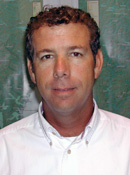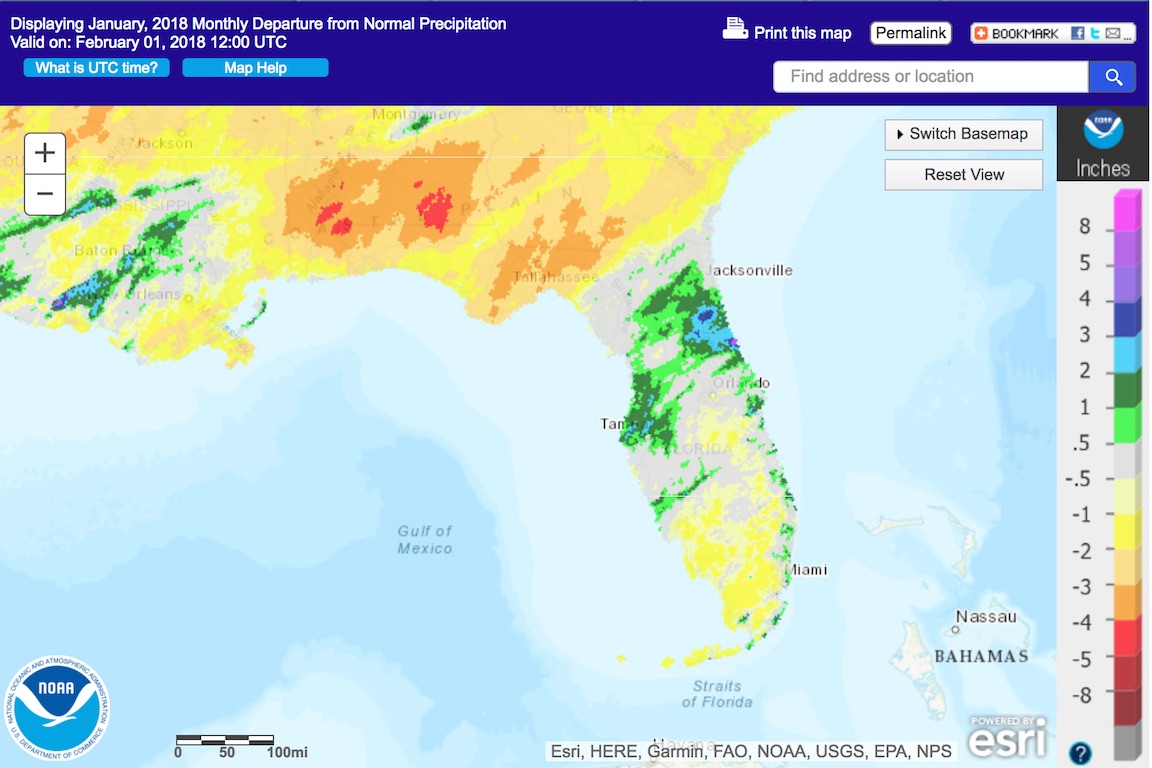Dear Florida Climate Center friends,
We'd like to present you with the January/February 2018 edition of our newsletter. In this newsletter, you'll find our December 2017 and January 2018 monthly climate summaries, an update on the La Nina event underway as well as current drought conditions and the spring outlook, and a round-up of staff outreach activities. If you have any questions, please send us an e-mail message at climate@coaps.fsu.edu.
Thanks,
The Staff of the Florida Climate Center
 |
 |
David Zierden
State Climatologist |
Danny Brouillette
Service Climatologist |
|
December and January Climate Summaries for Florida
The Florida Climate Center's
December 2017 Florida Climate Summary and
January 2018 Florida Climate Summary are now available. The monthly summary provides an analysis of temperature and precipitation patterns during the past month across the state, along with data on hazardous weather, drought, the impacts of the weather, and any records tied or broken for the month. During December, temperatures were above the historical median statewide, averaging 61.6 degrees Fahrenheit and ranking 38th highest on record since 1895.
This ranking was again at or above the median of the historical record for the 24th consecutive month (and above the normal for the 22nd), continuing a record-long streak
. The statewide-averaged rainfall total was below the historical median, coming in at 1.70", making for the 35th-driest December on record. During January, temperatures were below the historical median, for the first time in 25 months, averaging 54.8 degrees Fahrenheit and ranking 25th lowest on record since 1895. The statewide-averaged rainfall total was just above the historical median at 2.95", 58th highest in the instrumental record. La Nina (ENSO-negative) conditions continued to be observed in the equatorial Pacific Ocean. nnnnnn More details about both ENSO and drought are given later in the newsletter. Through the balance of December, the
NOAA Climate Prediction Center outlooks Florida for an enhanced probability of below-normal temperatures and equal chances of below-, near-, and above-normal rainfall.
The following table gives December average temperatures and departures from normal (˚F) for selected cities.
| Station |
Average Temperature |
Departure from Normal |
| Pensacola |
55.6 |
+2.1 |
| Tallahassee |
55.5 |
+2.3 |
| Jacksonville |
58.2 |
+2.9 |
| Gainesville |
57.7 |
+1.6 |
| Orlando |
64.4 |
+1.8 |
| Tampa |
67.3 |
+4.2 |
| West Palm Beach |
68.9 |
+0.8 |
| Miami |
71.7 |
+1.2 |
| Key West |
72.7 |
+1.3 |
The following table gives December precipitation totals and departures from normal (inches) for selected cities.
| Station |
Total Rainfall
|
Departure from Normal |
| Pensacola |
3.66 |
-0.89 |
| Tallahassee |
1.99 |
-1.91 |
| Jacksonville |
2.42 |
-0.38 |
| Gainesville |
2.65 |
+0.27 |
| Orlando |
0.35 |
-0.23 |
| Tampa |
0.85 |
-1.62 |
| West Palm Beach |
0.75 |
-2.63 |
| Miami |
0.66 |
-1.38 |
| Key West |
1.28
|
+0.88 |
The following table gives January average temperatures and departures from normal (˚F) for selected cities.
| Station |
Average Temperature |
Departure from Normal |
| Pensacola |
48.6 |
-2.8 |
| Tallahassee |
48.1 |
-3.1 |
| Jacksonville |
50.5 |
-2.6 |
| Gainesville |
50.1 |
-4.2 |
| Orlando |
60.2 |
-2.2 |
| Tampa |
59.7 |
-1.1 |
| West Palm Beach |
65.6 |
-0.1 |
| Miami |
68.1 |
-0.1 |
| Key West |
67.6 |
-1.8 |
The following table gives January precipitation totals and departures from normal (inches) for selected cities. Note that 0.1" of snow fell at Tallahassee on 3 January, contributing the total rainfall/liquid-equivalent precipitation.
| Station |
Total Rainfall |
Departure from Normal |
| Pensacola |
3.12 |
-1.51 |
| Tallahassee |
1.73 |
-2.61 |
| Jacksonville |
3.64 |
+0.34 |
| Gainesville |
4.32 |
+0.99 |
| Orlando |
2.35 |
-0.25 |
| Tampa |
5.00 |
+2.77 |
| West Palm Beach |
4.42 |
+1.29 |
| Miami |
1.01 |
-0.61 |
| Key West |
0.90 |
-1.14 |
The following schematics map December and January precipitation departures from normal, respectively, across Florida. Images courtesy of the National Weather Service.


|
|
Climatologist Speaks to Sixth-Grade Students
On 31 January, service climatologist Danny Brouillette spoke to Colleen Maley's sixth-grade science class at the Tallahassee School of Math and Science about clouds and precipitation as part of its class unit on weather. TSMS is a charter school located on the north side of Tallahassee. Brouillette gave a presentation in which students were able to ask questions. Students also were able to examine a rain gauge and a hail pad as well as view the classic cloud-in-a-bottle experiment.
|
|
Florida Climate Center Participates in FSU Day at the Capitol
|
|
| From left to right: Jeremy Rolph, Danny Brouillette, and Jocelyn Elya. |
As a member organization of the Center for Ocean-Atmospheric Prediction Studies (COAPS) at the Florida State University (FSU), the Florida Climate Center once again participated in FSU Day at the Capitol. Service climatologist Danny Brouillette joined other COAPS personnel Jocelyn Elya, Jeremy Rolph, Bethany Sanders, and Kris Suchdeve in manning a table at the event, which took place at the Florida Capitol on 6 February. They spoke to university officials, legislators, pages, lobbyists, and other politicos about projects and other activities in which they are engaged on a daily basis.
|
|
CoCoRaHS March Madness to Begin Soon
Later this week, March and climatological spring begin, and so does the annual CoCoRaHS March Madness effort. The goal of March Madness is to recruit as many new observers to the CoCoRaHS network as possible. The CoCoRaHS (or, Community Collaborative Rain, Hail, and Snow) network is a nationwide (plus Canada) effort of volunteer citizen scientists who take daily precipitation and other observations that form a high-density observational network. The state that recruits the most new volunteers wins the CoCoRaHS Cup. Florida won last year, as is pictured below.
In 2018, the hope is that Florida will win again! If you are interested in joining the network, just follow this
link. If you have questions or are a reporter looking to do a report on CoCoRaHS or or are with an organization that is positioned to promote CoCoRaHS, please contact service climatologist Danny Brouillette, who is co-coordinator of the network for Florida, at
dbrouillette@coaps.fsu.edu or 850-644-0719.
|
|
State Climatologist Speaks at University of Florida Levin College of Law Public Interest Environmental Conference

State Climatologist David Zierden represented the Florida Climate Center at the opening plenary session of the 24th annual Public Interest Environmental Conference hosted by UF's Levin College of Law on 8-10 February. The theme for this year's conference was "Climate: The Only Constant is Change".
This plenary session laid the foundation for further discussions about our climate over the course of the conference. Zierden discussed recent developments in climate science, including advances in observations and modelling, the emerging science of climate attribution, as well as the increasingly important role of climate science communications. Dr. Glenn Morris discussed several major areas of public health impacts from a changing climate, including heat stroke, air pollution-related impacts, and infectious disease. Professor Michael Gerrard wrapped up with the legal context, beginning with the Paris Accord, current U.S law and policy, recent government decisions that undermine the U.S. commitment to addressing climate change, and legal strategies and tools for responding to this reversal.
|
|
ENSO and Drought Update; Outlook for Spring
NOAA's Climate Prediction Center continues a La Nina Advisory owing to continued negative-ENSO conditions in the equatorial Pacific Ocean. However, the negative sea-surface-temperature anomalies in this region of the Pacific have decreased in magnitude in the last month, as shown in the plot just below.
Smaller negative anomalies foretell a return to ENSO-neutral conditions as the climatological boreal spring begins and proceeds. Ensemble modelling suggests this change of phase, as does the propagation of a Kelvin wave across the basin, and the official outlook calls for increased probabilities of neutral conditions in the coming few months.

For the period beyond this spring and early summer, it is too early to say with certainty what will be the ENSO phase. This time of year is a notoriously difficult one for forecasting ENSO for the following fall and winter because of the so-called spring-time prediction barrier. La Nina winters tend to be warmer and drier than normal in Florida. This largely has borne out as, even if January had colder-than-normal conditions with mixed results statewide on precipitation. December was warmer and drier than normal, and February looks as if it will have much warmer than normal conditions by the time the month is over. Drought has been problematic on the panhandle but is currently in a state retreat as shown by the most recent US Drought Monitor. However, dry conditions are beginning to appear on portions of the peninsula, which will need to be monitored carefully as spring wildfire season approaches.
The outlook for temperature and precipitation from the Climate Prediction Center for climatological spring (March-April-May) is consistent with the end of a La Nina episode - heightened odds of warmer- and drier-than-normal conditions in Florida and immediately adjacent parts of the Southeast.
|
|
State Climatologist Presents at the Wiregrass Cotton Expo
State Climatologist David Zierden once again presented a program on recent weather and climate and the Spring outlook for Tri-State farmers at the annual Wiregrass Cotton Expo on February 2. The Expo was hosted by University of Auburn Extension at the National Peanut Festival grounds in Dothan, Alabama. Zierden talked about the recent cold weather spell in January, developing drought, and how La Nina in the Pacific Ocean could lead to warmer and dry weather patters the remainder of winter and spring.
|
|
Florida Climate Center in the News
|
| About Us The Florida Climate Center is part of a three-tiered system of national, regional, and state climate offices, including NOAA's National Centers for Environmental Information (NCEI - in Asheville, North Carolina) and the Southeast Regional Climate Center (in Chapel Hill, North Carolina). The Florida State Climatologist and other staff at the Florida Climate Center provide the following information and services to the people of Florida:
· Climate Data: Historical weather observations for weather stations throughout the state of Florida. We are able to provide data for most stations from 1948-present.
· Climate Information: Long-term historical averages for various stations, climate divisions, and the entire state.
· Extreme Event Records: Information and analyses on extreme events such as freezes, droughts, floods and hurricanes.
· Special Analysis: With their vast knowledge of El Niño, La Niña and climate variability, the State Climatologist and staff can offer expert insight into Florida's climate trends.
· Outreach: Activities, presentations, and workshops that inform and educate the people of Florida about current and emerging climate issues. We also coordinate volunteers for the Community Collaborative Rain, Hail & Snow Network (CoCoRaHS).
More About Us |
|